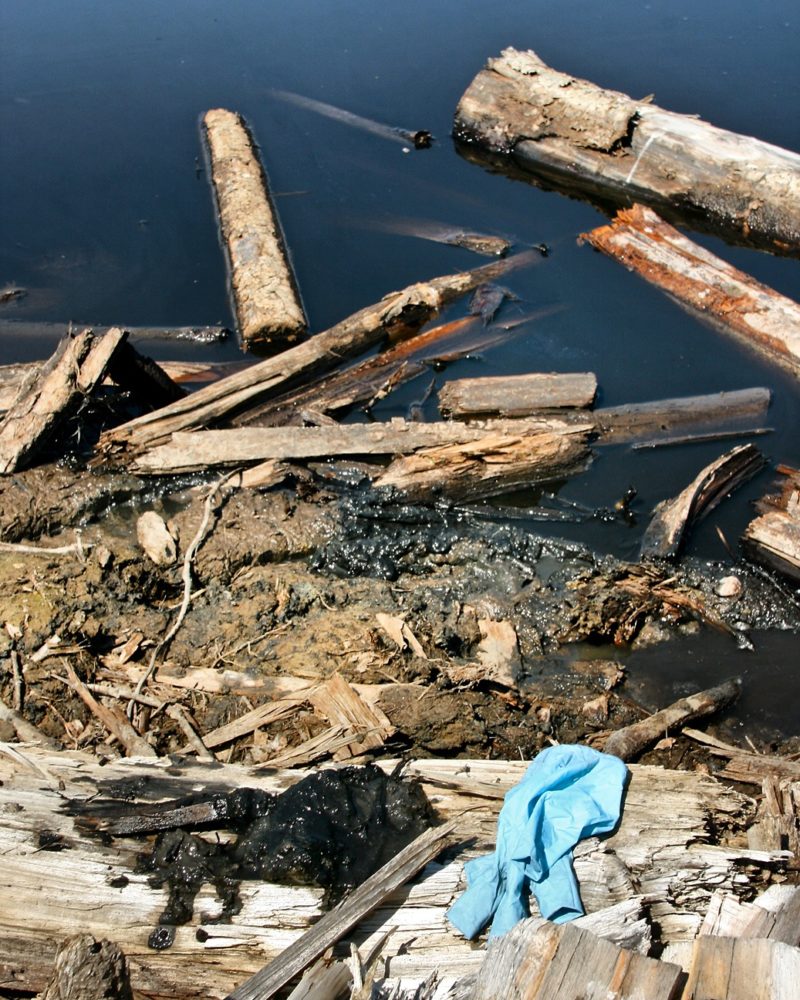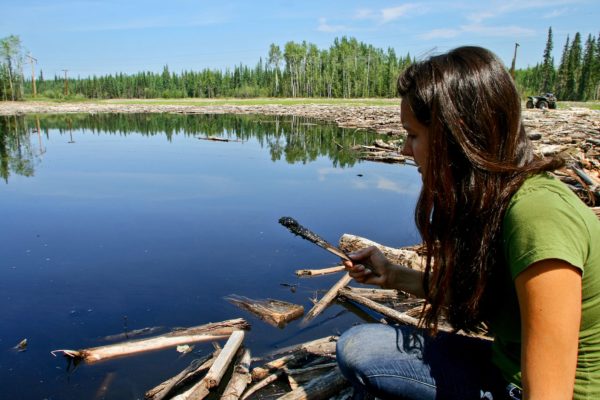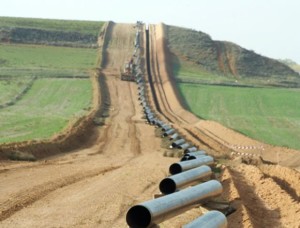What cause do Native Americans have to believe so much risk is inherent with oil pipelines? Oil companies tout statistics of their safety and comparative incident levels to other transport. What is it about pipelines that has hundreds of tribes across the U.S. and Canada uniting to the point that even ancient enemy tribes with very real and painful pasts between them are standing up together? An answer to that question, can be found in Canada. There have been hundreds of pipeline spills on First Nations indigenous territory there. They have been devastating. Native people in the United States have been aware of these issues their northern brothers and sisters face for a long time. Many tribes in the U.S. have strong ties with Canadian First Nations that have nothing to do with colonial borders. Tribes in the U.S. have been staging protests for years of tar sands equipment and oil headed to or from Canada, as well as pipelines like the Keystone XL. Now, many of the same patterns that Canada has been exercising when it comes to indigenous lands and pipeline development, are happening in the United States. That is why the people at Standing Rock are trying to stop the Dakota Access Pipeline; they do not want to endure what they know their indigenous relatives in the north have already suffered.
The Alberta oil sands operations are the second largest source of crude oil in the world after Saudi Arabia. The oil sands deposits encompass over 50,000 square miles of Boreal forest sub-surface, an area almost the size of Florida. They are bisected by the Athabasca River system, a primary source of water and food subsistence for the indigenous populations of the region. All of the surface earth and trees must be removed via strip mining to access the oil underneath. As of now hundreds of square miles of forest have been disturbed by surface mining. Oil sands production uses 2-4 barrels of water to produce one barrel of crude oil by extracting bitumen tar from the sand and soil. Over 20 billion cubic feet of water are diverted from the Athabasca River every year to perform this process. Lakes of toxic wastewater so large they can be seen from space are created to hold and reclaim the tailings produced. They sit right next to the Athabasca River, and it has been estimated that a billion gallons of wastewater leak from the lakes each year.
Over 800 spills have occurred on indigenous land in Canada from the pipelines that transport tar sands bitumen (which is much more toxic and difficult to clean up than regular oil). The remote fly-in community of Ft. Chipewyan that sits downriver from the wastewater lakes has had rare cancer rates spike to an extremely abnormal level. Fishermen find deformed fish and hunters find infections and diseases in local game populations. Herds of caribou have been decimated or dispersed by mining operations, and have become much harder to utilize for subsistence along with other wild food sources. Most remote indigenous communities have nothing more than “convenience store” items at local stores, if they even have stores. So the loss of subsistence is a serious problem. The oil sands operations are the fastest growing source of greenhouse gas emissions in Canada, (compounded by the fact Boreal forest is being removed to create them). Oil sands emit twice as much sulfur dioxide per barrel as other oil production sites. These operations have become increasingly detrimental to the indigenous cultures present where they take place. Both in terms of destroying a cultural way of life, as well as in the physical health and well-being of the people affected. Some of those communities are among the last indigenous communities in North America that still rely almost entirely on subsistence from the land around them, and their cultures, histories, and heritage are closely tied to that subsistence lifestyle. Their way of life is under threat by resource development. Over 130 Canadian First Nations have stated their condemnation and rejection of tar sands development, and the dangerous pipelines and shipping required to facilitate it.
The following images demonstrate one reason why:
![[A Plains Midstream oil tanker rolls past the Enbridge oil refinery in Edmonton, AB. In 2011, the Plains Midstream oil company was responsible for one of Alberta's largest pipeline spills that poisoned the Lubicon Cree First Nation community of Little Buffalo. The local school had to be evacuated and many children and elders fell sick from toxic fumes released by the pipeline. It destroyed a local muskeg water resource for the village. Enbridge is responsible for the Kalamazoo, MI, tar sands pipeline spill of 2009. The oil that spilled there was pumped from the refinery that can be seen belching flames in the background of this photo. ]](https://indigenousrising.org/wp-content/uploads/2016/12/IMG_7997-e1482434789294.jpg)
[A Plains Midstream oil tanker rolls past the Enbridge oil refinery in Edmonton, AB. In 2011, the Plains Midstream oil company was responsible for one of Alberta’s largest pipeline spills that poisoned the Lubicon Cree First Nation community of Little Buffalo. The local school had to be evacuated and many children and elders fell sick from toxic fumes released by the pipeline. It destroyed a local muskeg water resource for the village. Enbridge is responsible for the Kalamazoo, MI, tar sands pipeline spill of 2009. The oil that spilled there was pumped from the refinery that can be seen belching flames in the background of this photo. ]
![[Lubicon Cree tribal member, Melina Laboucan-Massimo, examines a bottle of black oily water taken from a muskeg that was polluted by the 28,000 barrel Little Buffalo pipeline spill. This muskeg once teemed with life, and provided an important fishing and hunting location for the Lubicon Cree village of Little Buffalo. The spill was one of Canada's worst among the hundreds of catastrophic ruptures crisscrossing Canadian indigenous territories. When this photo was taken, the Plains Midstream oil company had called the site, "rehabilitated" and “reclaimed”, which at that time the government accepted without oversight. We were the first non-employees allowed on the site, as it had been closed off for over a year, even to tribal members whose land it was on. After the announcement was made that the muskeg had been rehabilitated in June of 2012, we ventured out to investigate for ourselves. It’s been argued by many that it is not possible for an ecosystem to ever fully recover from a tar sands bitumen spill. According to the people who utilized this muskeg for thousands of years, it was anything but “rehabilitated”. ]](https://indigenousrising.org/wp-content/uploads/2016/12/14045832_10154552204838694_493950607847041902_n.jpg)
[Lubicon Cree tribal member, Melina Laboucan-Massimo, examines a bottle of black oily water taken from a muskeg that was polluted by the 28,000 barrel Little Buffalo pipeline spill. This muskeg once teemed with life, and provided an important fishing and hunting location for the Lubicon Cree village of Little Buffalo. The spill was one of Canada’s worst among the hundreds of catastrophic ruptures crisscrossing Canadian indigenous territories. When this photo was taken, the Plains Midstream oil company had called the site, “rehabilitated” and “reclaimed”, which at that time the government accepted without oversight. We were the first non-employees allowed on the site, as it had been closed off for over a year, even to tribal members whose land it was on. After the announcement was made that the muskeg had been rehabilitated in June of 2012, we ventured out to investigate for ourselves. It’s been argued by many that it is not possible for an ecosystem to ever fully recover from a tar sands bitumen spill. According to the people who utilized this muskeg for thousands of years, it was anything but “rehabilitated”. ]

![[Photos above: Protective gloves had to be used to remove samples of the black sludge in the pond just under the surface of the mud. It reeked of a chemical smell, and stained skin and clothing black. When the water that had seeped back into the muskeg was disturbed, black fluid and bubbles would float to the surface. Streaks of black could be seen flowing in the pond's natural circulation. The muskeg had been entirely drained and filled with pieces of wood used to help absorb the oil. It covered shores that were once covered with plant life. Rehabilitation efforts by the company did not include investigation into local groundwater effects.]](https://indigenousrising.org/wp-content/uploads/2016/12/IMG_8001-e1482434900171.jpg)
[Photos above: Protective gloves had to be used to remove samples of the black sludge in the pond just under the surface of the mud. It reeked of a chemical smell, and stained skin and clothing black. When the water that had seeped back into the muskeg was disturbed, black fluid and bubbles would float to the surface. Streaks of black could be seen flowing in the pond’s natural circulation. The muskeg had been entirely drained and filled with pieces of wood used to help absorb the oil. It covered shores that were once covered with plant life. Rehabilitation efforts by the company did not include investigation into local groundwater effects.]
![[Melina looks at a black sludgy substance that hides just under the surface of the mud around the muskeg. Fresh wolf tracks pass through the mud, disturbing the sludge underneath. The entire location reeked of a strong diesel-like smell. One of the elders on location with us told stories of seeing both moose and wolves licking the pipelines at the joints, where chemicals that were an attractant to them would seep out. Melina works as a climate campaigner for GreenPeace, as well as an indigenous rights activist. Upon our return from the site they publicly released documentation of its condition, which triggered the government oversight that had been lacking until that point. About 6 months later Alberta's Energy Resource Conservation Board issued four high-risk enforcement actions against Plains Midstream. The investigation revealed operational failures by the company, including inadequate leak detection and emergency response. An ERCB high-risk enforcement action indicates that the incident has both public safety and environmental impacts. It is the most serious offence companies can be found in non-compliance with. According to the ERCB, the pipeline was shut down for 122 days.]](https://indigenousrising.org/wp-content/uploads/2016/12/IMG_8002-e1482434932321.jpg)
[Melina looks at a black sludgy substance that hides just under the surface of the mud around the muskeg. Fresh wolf tracks pass through the mud, disturbing the sludge underneath. The entire location reeked of a strong diesel-like smell. One of the elders on location with us told stories of seeing both moose and wolves licking the pipelines at the joints, where chemicals that were an attractant to them would seep out. Melina works as a climate campaigner for GreenPeace, as well as an indigenous rights activist. Upon our return from the site they publicly released documentation of its condition, which triggered the government oversight that had been lacking until that point. About 6 months later Alberta’s Energy Resource Conservation Board issued four high-risk enforcement actions against Plains Midstream. The investigation revealed operational failures by the company, including inadequate leak detection and emergency response. An ERCB high-risk enforcement action indicates that the incident has both public safety and environmental impacts. It is the most serious offence companies can be found in non-compliance with. According to the ERCB, the pipeline was shut down for 122 days.]
![[Children from the Lubicon Cree village of Little Buffalo play in the school yard at a community function in the photo above. This school had to be evacuated and closed for a week after the nearby pipeline spill. Many children fell ill with various symptoms. Thinking something was poisoning the school, teachers evacuated children out of the building and into the invisible fumes that surrounded it. They weren’t given notice of the spill until long after people at the school and village had fallen sick.]](https://indigenousrising.org/wp-content/uploads/2016/12/IMG_8004-e1482435106835.jpg)
[Children from the Lubicon Cree village of Little Buffalo play in the school yard at a community function in the photo above. This school had to be evacuated and closed for a week after the nearby pipeline spill. Many children fell ill with various symptoms. Thinking something was poisoning the school, teachers evacuated children out of the building and into the invisible fumes that surrounded it. They weren’t given notice of the spill until long after people at the school and village had fallen sick.]
![[The dots seen around these children playing at the Little Buffalo school are mosquitoes. What seems a minor annoyance if any to the Lubicon Cree, was an unlivable pestilence to me. Although, clouds of mosquitoes might seem of little concern to anyone when compared to clouds of toxic gas.]](https://indigenousrising.org/wp-content/uploads/2016/12/IMG_8003-e1482434990439.jpg)
[The dots seen around these children playing at the Little Buffalo school are mosquitoes. What seems a minor annoyance if any to the Lubicon Cree, was an unlivable pestilence to me. Although, clouds of mosquitoes might seem of little concern to anyone when compared to clouds of toxic gas.]
![[Heading far into the bush to moose hunting camp, Melina keeps an eye out of the back of the truck. Often on remote bush roads moose will step out into the road after a vehicle passes. Subsistence living involves taking any and every opportunity to feed your family. The bush is so thick it's impossible to see more than a few feet into it. This makes it necessary to hunt moose at clear areas like muskegs or the occasional open meadow. As oil development has increased on indigenous lands, some tribes who still rely on subsistence practices have had to travel farther and farther from their homes to find game. Others living close to oil development or downstream from refineries, are finding fish and game infected with strange diseases.]](https://indigenousrising.org/wp-content/uploads/2016/12/IMG_8005.jpg)
[Heading far into the bush to moose hunting camp, Melina keeps an eye out of the back of the truck. Often on remote bush roads moose will step out into the road after a vehicle passes. Subsistence living involves taking any and every opportunity to feed your family. The bush is so thick it’s impossible to see more than a few feet into it. This makes it necessary to hunt moose at clear areas like muskegs or the occasional open meadow. As oil development has increased on indigenous lands, some tribes who still rely on subsistence practices have had to travel farther and farther from their homes to find game. Others living close to oil development or downstream from refineries, are finding fish and game infected with strange diseases.]
![[ Melina's father, Billy Joe, is chief of the Lubicon Cree. He led us on an unsuccessful moose hunt to find food for the family. Here he returns from a foray into the bush to try and get a clear shot at an elk we spotted. We saw no moose, and one elk during the hunt. He didn't get the shot.]](https://indigenousrising.org/wp-content/uploads/2016/12/IMG_8010.jpg)
[ Melina’s father, Billy Joe, is chief of the Lubicon Cree. He led us on an unsuccessful moose hunt to find food for the family. Here he returns from a foray into the bush to try and get a clear shot at an elk we spotted. We saw no moose, and one elk during the hunt. He didn’t get the shot.]
![[While we didn't find big game on this hunt, subsistence practices are about using whatever the land provides. What we found that day was a grouse, and some wild strawberries. Billy Joe killed the grouse to give us for dinner that night. He explained how he always leaves the meat of the thighs and legs for the forest creatures to eat, and takes only the breast. When one sees all life as relations, one remembers never to take more than they need and to always give something back. Upon cleaning the grouse, he discovered the stomach contained some of the same berries we had been feasting on. He told us that when a grouse is found to have berries in its stomach, a tradition was to inflate the stomach with air and tie it into a ‘balloon’. It was then hung in a lodge somewhere. When a person is caught standing under it, they have to tell a story. Stories are the binders of family, culture, and respect for life among the Cree. They believe that they cannot allow the traditions and practices tied to those stories, such as sustainably harvesting the gifts of the Earth, to be threatened or lost in the name of profit. On April 26, 2013, Plains Midstream Canada was charged with three counts of violating environmental protection laws relating to the spill. The charges pertain to: "the spill itself, failing to take all reasonable measures to repair the problem, and not pursuing all steps possible to remediate and dispose of the oil". Today, a few hundred miles to the south, the residents of the Standing Rock Reservation have been arrested while praying that their water never meets the fate of the waters of the Lubicon Cree.]](https://indigenousrising.org/wp-content/uploads/2016/12/IMG_8009.jpg)
[While we didn’t find big game on this hunt, subsistence practices are about using whatever the land provides. What we found that day was a grouse, and some wild strawberries. Billy Joe killed the grouse to give us for dinner that night. He explained how he always leaves the meat of the thighs and legs for the forest creatures to eat, and takes only the breast. When one sees all life as relations, one remembers never to take more than they need and to always give something back. Upon cleaning the grouse, he discovered the stomach contained some of the same berries we had been feasting on. He told us that when a grouse is found to have berries in its stomach, a tradition was to inflate the stomach with air and tie it into a ‘balloon’. It was then hung in a lodge somewhere. When a person is caught standing under it, they have to tell a story. Stories are the binders of family, culture, and respect for life among the Cree. They believe that they cannot allow the traditions and practices tied to those stories, such as sustainably harvesting the gifts of the Earth, to be threatened or lost in the name of profit. On April 26, 2013, Plains Midstream Canada was charged with three counts of violating environmental protection laws relating to the spill. The charges pertain to: “the spill itself, failing to take all reasonable measures to repair the problem, and not pursuing all steps possible to remediate and dispose of the oil”. Today, a few hundred miles to the south, the residents of the Standing Rock Reservation have been arrested while praying that their water never meets the fate of the waters of the Lubicon Cree.]
Follow Joe Whittle on Instagram @JoeWhittlePhotography




